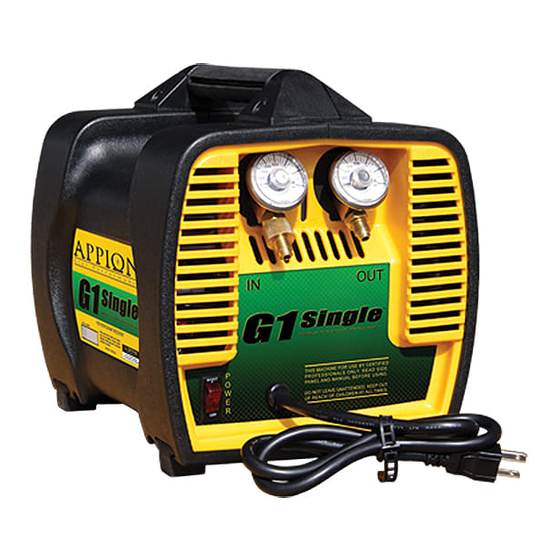Appion G1 Single 운영 매뉴얼 - 페이지 11
{카테고리_이름} Appion G1 Single에 대한 운영 매뉴얼을 온라인으로 검색하거나 PDF를 다운로드하세요. Appion G1 Single 20 페이지. Single cylinder

Additional Machine Usage
PURGING NON-CONDENSABLES FROM RECOVERY CYLINDERS
In the event that the Recovery Cylinder pressure is higher than expected, or if the recovery process
seems slower than usual, use an external gauge (not the gauge on the G1Single) and a Refrigerant
Pressure/Temperature chart to check for the presence of non-condensable gases in the cylinder.
You can bleed/purge non-condensables into another cylinder following this procedure:
1. The Recovery Cylinder must remain undisturbed for at least 24 hours for the non-condensables to
rise to the top of the cylinder.
2. Through a Manifold Gauge Set, connect the Recovery Cylinder Vapor Port to the Vapor Port of a
second recovery cylinder.
3. Consult a Refrigerant Pressure/Temperature chart, and check the temperature of the Recovery
Cylinder to determine what the pressure should be.
4. While the pressure is higher than the pressure on the chart, slowly open the Vapor Port to bleed off
excess pressure until it is about 5 psi (0.35 Kg/cm
5. Close the valves and let the cylinder stand still for 10 minutes. Repeat if necessary.
⚠ NOTICE
The US EPA only allows purging if done into a secondary cylinder. Once a recovery
cylinder has refrigerant inside, it may never be opened directly to atmosphere.
CHANGING BETWEEN REFRIGERANT TYPES
Appion refrigerant recovery machines are unique in that there is no refrigerant directly introduced into
the compressor crankcase. This allows the G1Single to easily and efficiently clear out refrigerant at
the end of the recovery process. However, as with all recovery machines, trace refrigerant vapors may
remain and should be cleared out when switching between different types of refrigerant.
When you are changing between refrigerant types, any refrigerant remaining in the recovery machine
should be drawn into a deeply evacuated cylinder before switching. Then, to prevent any cross-
contamination, it is recommended that a vacuum pump be connected to the output port of the G1Single
(with a closed ball valve attached to the input port), and run the vacuum pump to completely evacuate
the machine of any trace refrigerant vapors.
STORING THE MACHINE BETWEEN USES
When storing the machine between recovery jobs, trace refrigerant vapors can continue to wear on the
internal components of the machine. If the machine is fully sealed (closed valves or port covers), storing
the machine in a hot truck can cause the trace vapors to expand and wear on the components further.
To minimize wear during storage, you can use port caps/covers to protect the machine from dirt, but
make sure they do not have an airtight seal.
) above the pressure listed on the chart.
2
11
© 2012 APPION INC. - ALL RIGHTS RESERVED
G1SINGLE OPERATION MANUAL
